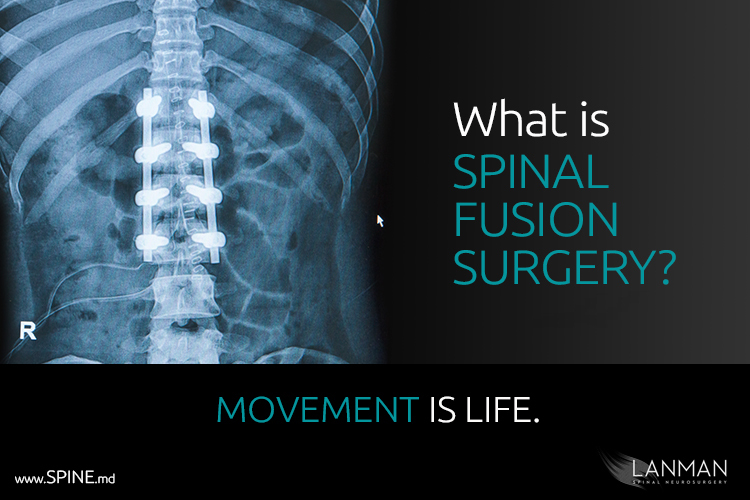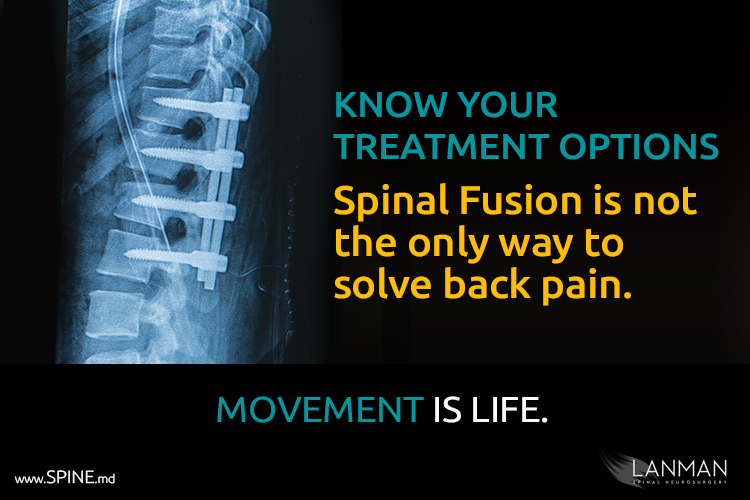For decades, spinal fusion was considered one of the best surgical options for treating back pain. When you experience prolonged back pain, it is often because your spinal discs are damaged and are no longer able to protect your vertebrae. Your vertebrae allow you to move, bend, twist, and navigate the world comfortably, and each one is cushioned by spinal discs, which work as shock absorbers and prevent the vertebrae from rubbing against each other. When these discs degenerate, the vertebrae rub together, causing symptoms like pain, numbness, and loss of mobility.
Spinal fusion is an operation that removes the problem discs and fuses the vertebrae instead. This reduces pain, but it also reduces the mobility of patients. Depending on the fusion location, patients might have a harder time bending over or moving their necks after the operation.
When a patient needs spinal surgery, their spine specialist will often look for alternatives before recommending this option, because of the chance of reduced mobility or further degeneration of adjacent discs. Learn more about spinal fusion alternatives and why patients and doctors increasingly avoid this procedure.
Why Patients Seek Alternatives to Spinal Fusion
There are many reasons why people look for spinal fusion alternatives before agreeing to this operation. The first is the fear of surgery. Even the most minimally-invasive spinal procedures require downtime for the patient and may require several weeks of physical therapy and time off work. Some patients worry they can’t handle the pain while others don’t think they have time to rest and recover. Instead, they seek out physical therapy, heat therapy, exercise, pain medication, and other non-invasive treatments.
Additionally, some patients search for modern alternatives to traditional spinal fusion surgery. There are alternative operations to consider that might be more effective, less invasive, and drive better results.
Get to know a few surgical and non-surgical spinal fusion alternatives so you can treat the pain in your back and continue living comfortably.
9 Surgical Options That Are Spinal Fusion Alternatives
Spinal fusion isn’t the only surgical treatment option for your back pain. Here are a few alternative procedures your doctor may recommend instead.
1. Artificial Disc Replacement
Artificial disc replacement involves removing broken discs and replacing them with artificial ones. This is more advanced than spinal fusion because the problem disc is replaced, allowing the vertebrae to move against each other naturally. Doctors can remove one disc at a time or replace multiple broken discs at once.
Patients can enjoy greater mobility with ADR instead of with spinal fusion because their vertebrae aren’t fused together.
2. Disc Regeneration
If the pain in your back is caused by degenerative disc disease, you may be a candidate for disc regeneration. Through a series of injections, your body is stimulated to start growing disc tissue. This helps worn-out discs grow back, providing increased cushioning and reduced pain in the targeted area.
While this is considered a medical intervention, it is not technically a surgical procedure. The injections take about 30 minutes and no general anesthesia is needed.
3. Posterior Dynamic Stabilization
This treatment is considered an internal brace. The brace controls the movement of the spine and prevents patients from feeling pain as a result. This surgical option was developed alongside spinal fusion and – in some cases – can be considered a form of spinal fusion or completed during the same operation.
As modern surgical technology improves, doctors are able to use better materials that increase mobility and drive higher success rates.
4. Microdiscectomy
A microdiscectomy is used to treat sciatica or herniated discs. Instead of removing the entire disc, a microdiscectomy removes the problematic areas that are hitting the nerves. If a spinal disc is pushed out into the nerve canal, patients can start to feel pain. This can be a dull ache as the disc rests against the nerves or sudden spasms every time the disc is pushed into them.
By removing part of the disc, the patient can avoid spinal fusion surgery and can maintain their mobility levels with the help of the remaining disc material.
5. Intradiscal Electrothermal Coagulation
This procedure involves applying heat to the annulus in the spine. This is used to treat lower back pain when the patient doesn’t respond to surgical treatments. In some cases, your doctor may recommend an annuloplasty, which involves repairing or replacing the annulus to reduce your pain levels.
6. Motion Preservation Technologies
Additionally, your doctor may recommend the use of motion preservation technology that serves as a spinal fusion alternative. These technologies work to remove pain without reducing your ability to bend and turn.
Motion preservation has become a key goal in the world of spinal health as doctors work to treat conditions without liming the movement of patients. This allows them to return to work and their favorite recreational activities after treatment.
7. Percutaneous Endoscopic Discectomy
A discectomy refers to the removal of a spinal disc that is causing patients pain. The other two words, percutaneous endoscopic refer to how the disc is removed. The surgeon uses an endoscope that projects an image onto a television for the doctor and their team to watch.
In many cases, spinal surgeons will enter through your neck for cervical spine treatment or through your abdomen for lumbar treatment. This allows the doctor to avoid your delicate nerve canal. However, this treatment takes a posterolateral approach, which means the surgeon enters through your back. Each entry point is strategically designed to minimize risk to the patient and recovery time. With this operation, it is easier to get to the spinal discs.
8. Laminectomy
A laminectomy targets the lamina, or the plate of bone that protects the spine and nerve canal. Over time, your lamina can continue to grow, leading to the development of bone spurs. These can be incredibly painful and can affect your nerves. A laminectomy removes the damaged part of the lamina, allowing patients to reduce their pain levels.
The main goal of a laminectomy is to reduce pressure on the spinal canal so your nerves, vertebrae, and spinal discs have enough space to function comfortably. Laminectomies can be performed in the lumbar or cervical areas of the spine.
9. Regenerative Treatment
Doctors have also started exploring stem cell treatment to address problems with spinal discs. The goal is to stimulate growth so broken and worn-down discs can grow back to their healthy forms. In some cases, the doctor might complete a microdiscectomy on the damaged disc to remove damaged tissue and then start stem cell therapy to help healthy material grow back in its place.
Non-Surgical Alternatives:
You might be able to avoid surgery entirely if you have back pain. Here are a few ways that medical experts help patients reduce their pain levels and treat mild back conditions.
1. Physical Therapy
Your doctor may recommend a series of exercises that you can complete to reduce back pain. These exercises are meant to help you stretch your back muscles and promote good spinal hygiene. You may be able to do these exercises at home or you will meet with a professional physical therapist.
2. Cold and Warm Pads
Both heat and cold therapy can help treat back pain. Heat can relax the muscles and reduce tension, while cold can numb the area and reduce inflammation. Depending on the source of your pain, you might use heat therapy, cold therapy, or both to feel better.
3. Massage
Massage is a common treatment option to address back discomfort. Professional orthopedic massage can alleviate lower back pain in the short run. However, it is important that you are clear about your condition ahead of the massage and the therapist knows how to address the issue.
4. Exercise
Some people don’t want to move when they are in pain, but exercise can actually reduce pain levels when done correctly. Ask your doctor about beneficial low-impact exercises to help your back. These might include swimming, biking, or pilates.
5. Rest
Resting your back (and the rest of your body) can do wonders to reduce pain levels. You may benefit from taking time off work and spending time off of your feet to let your body heal.
6. Wait and See
This is one of the most common treatment methods, but also the least effective. While back pain might heal over time, it is likely to worsen the longer you wait without seeking help. Additionally, delaying treatment also means you spend more time wondering about your condition without getting a clear diagnosis.
Never Avoid Treatment for Your Back Pain
When patients start to experience back pain, they assume the worst. They are afraid that they will need surgery and could lose mobility because of the procedure. However, ignoring your pain means putting your life on hold as your condition gets worse. Don’t wait to experience life without pain – seek expert help.
Dr. Todd H. Lanman is the founder of the Advanced Disc Replacement Spinal Restoration Center. He is a leading spinal expert and is well-respected by colleagues and patients across the country. He always starts with non-surgical alternatives to treat back pain and then uses the most advanced techniques to address problems that can’t be solved with physical therapy and rest. He will avoid spinal fusion surgery whenever possible.
Request a consultation today and take the first steps to treat your back pain. Whether you feel dull aches throughout the day or unexpected shocks and numbness, Dr. Lanman can diagnose and treat your condition, and get you back to living your active life.







